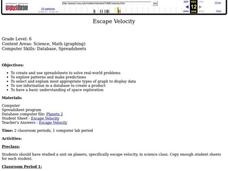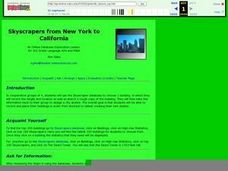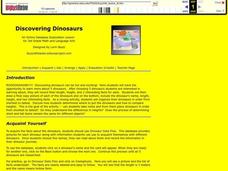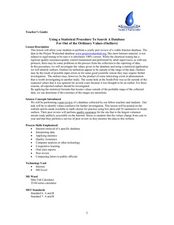Curated OER
European Elevation Sort
Given a prepared database of European countries, sixth graders sort the countries in ascending order by elevation and identify the five countries with the highest elevations. This cross-curricular lesson combines elements of computer...
Curated OER
Metrically Me!
Students define the parts of a database, search strategies to locate information electronically, create/modify databases, etc. and enter data into a prepared spreadsheet to perform calculations.
Curated OER
Escape Velocity
Sixth graders create/use spreadsheets to solve real-world problems, explore patterns, make predictions, select/explain most appropriate types of graph to display data, use information to create product, and have basic understanding of...
Curated OER
Finding Your Way in the World Wide Web
Researchers practice grouping items to explore the concept of a database. They apply these concepts to the WWW search engine format and consider why it is important to enter the most specific information.
Curated OER
Self Advocacy
Students determine the procedures for facilitate a self-advocacy meeting. They enter information about the meetings in a database which they include in a letter summarizes the meeting.
Curated OER
Review of the United States of America
Students research and compile information for each US state. They write a paragraph on one of the topics found within the database comparing at least 2 states. They create a database with the information they collected about each US state
Curated OER
Organizing our Favorite Books
Students identify the title and author of stories. They create a database that supplies both graphic and written information to identify a book.
Curated OER
Kinzi Deaf Alumni
Students use data of school alumni to create a database. The instructional activity uses technology and access to a computer lab is essential. The concepts of graphing statistics is also used to help teach across the curriculum.
Curated OER
Land or Sea?
Sixth graders access a database to search for desired information, using "and" or "or" connectors where necessary. They choose a connector and search a prepared database of European countries to locate which countries border certain...
Curated OER
How Much Do You Burn?
Sixth graders discover their weight relative to the other children in their class. They determine how many calories they burn through exercise and compare it with their classmates. Using the internet, they calculate their body mass index...
Curated OER
Skyscrapers from New York to California
Third graders use an online database to gather information on skyscrapers. Using the information, they choose one building and record its height and location. In groups, they design a city skyline including the skyscraper they choose....
Curated OER
Discovering Dinosaurs
Third graders use an online database to gather information about five dinosaurs that are of interest to them. Using a chart, they record their length, height and two interesting facts for each dinosaur. They draw a picture of the...
Curated OER
Birds - Beaks and Feet
Second graders use an online database to research information about bird's beaks and feet. Using that information, they discover what foods they eat and where they live. In groups, they cluster the food/habitat and beak/feet data to make...
Curated OER
How Are Plants Similar And Different?
Studetns create an index card database of different categories of plants such as bushes, trees, flowers, grasses and vegetables. They review the different parts of a plant and label pictures of plants on the database cards. They use the...
Curated OER
Doughnuts to $ Database
Fifth graders are selling Krispy Kreme doughnuts to raise money for their overnight camping trip. They use a database to set to keep track of and record additions to their daily sales. Students then follow the step by step directions to...
Curated OER
Student Census
Students collect data from their peers and store the information in a database. As students manage the information they realize the usefulness of a database as a tool to manage large amounts of information in an efficient and accurate...
Curated OER
Graphically Speaking
Students discover the links between population and Congressional representation. In this government lesson, students research population statistics and create spreadsheets that compare population to the number of Congress members per state.
Curated OER
For the Record: Black Inventors and Inventions
Students research the Internet for information about African-American inventors and their inventions. After collecting their data, students must build and manage information in a database that catalogs the inventions of African-Americans.
Curated OER
For The Record
Students create a database that catalogs their music collection of CD's and tapes. They sort, analyze and print selected database records in answer to questions about their favorite music recordings and performing artists. Each student...
Curated OER
Burning It Up
Students explore energy as it relates to body function. Data about the personal physical activity of students is gathered and entered into a database which is utilized to test hypotheses made.
Curated OER
Disasters - Where, When, Why
Fourth graders research natural disasters that have occurred in the US in the twentieth century. They create computer based database and use the information to write a paragraph.
Curated OER
Learning Theories
Students access the ERIC database and search for the resources on learning theories. They use the features of ERIC to bookmark sources and then use Excel to create a summary of the database search.
Curated OER
Make Your Own Database
In this database worksheet, students follow directions on how to make their own database. Students complete 3 steps total.
Curated OER
Using a Statistical Procedure To Search A Database For Out of the Ordinary Values
Students develop a spreadsheet containing formulas and find summaries for them. In this investigative instructional activity students choose a topic, investigate it and use MS Excel to sort data.

























